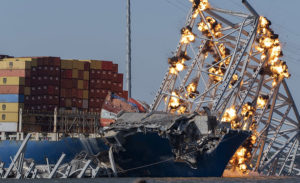How can owners prepare for uncertainty? Per this year’s top professional services firms, the answer is early and often. As interest rate hikes slow market inflation, more owners turn to third-party managers to weigh project costs and seek savings. But firms say ongoing shortages could jeopardize project profitability without more collaboration.
After last year’s record-setting inflation rates, owners are revising their construction program priorities, says Sofia Berger, senior vice president of WSP USA’s transportation national business line. The company is ranked No. 10 on this year’s Top 50 program management (PM) list and No. 6 in construction management (CM).
“The unpredictability of future construction material costs has caused more variability in the bidding of design-build projects,” she explains. “That said, on the whole, the Bipartisan Infrastructure Law’s funding has increased overall infrastructure construction despite the inflationary impact.” According to many top professional services firms, the Federal Reserve’s goal to cool economic growth by raising interest rates is already having an effect on project financing. Yet owners are not ready to completely freeze their projects just yet.
Related Links:
ENR 2023 Top 100 Professional Services Firms
ENR 2023 Top 50 Program Management Firms
View complete 2023 list, with full market analysis
(Subscription Required)
Rescoping Risks
As interest rates climb, Mark Anderson, CEO of MGAC, says he is seeing more clients “be selective any time debt financing is necessary for a project.” The company is ranked No. 42 in PM and No. 28 in CM.
Anderson adds that the traditional pro forma methods of calculating financial results don’t look as “attractive” during periods of higher interest rates. “So looking at creative options to offset the additional cost of capital have come in several ways,” he explains. “This has involved more intensive planning, up-front financial analysis, and cost modeling to inform the design from the onset of the project and begin the value management process as the design process starts.”
Alternative contract structures such as design-build and CM-at-risk with a guaranteed maximum price have made for better collaboration and cost controls on MGAC projects, says Anderson. “Regardless of contract type, we continue to promote early team engagement, collaboration, and transparency throughout the design and construction process to ensure we are identifying and resolving challenges quickly and early in the project lifecycle,” he says.
For some top firms, the solutions to last year’s problems are proving to be this year’s challenges. With the Fed expecting to hike interest rates at least two more times this year, potentially pushing the country into a recession, owners are leaning on professional services firms now more than ever to guide them through a looming period of uncertainty. To meet owner demands and build the capacity of their services, top firms say they are reconfiguring operations to rescope how they use employees and productivity resources.
Balancing Supply and Demand
Material price increases, volatile supply chains and cost of living and labor shortages are all challenges stemming from supply and demand that professional services firms are grappling with in their own way, says Gardiner & Theobald director Josh McCrow. Owners are leaving no stone unturned in seeking ways to save costs,“from superstructure, MEP systems, cladding systems all the way through interior finishes and small scope items,” he explains.
For Gardiner & Theobald, the value engineering process begins with an efficiently designed building. “Not only from a building structure and system point of view but also from a program and square footage perspective,” McCrow says. “The timing of procurements has been critical—reading the market and buying out the project at the right time with the right level of information.”
To combat the industry’s “poor” track record for on-time delivery, McDonough Bolyard Peck President and CEO Chris Payne says the company has found success in integrating data analytics to highlight schedule trends in a more visible way for owners.
On the labor front, he says the firm needed to change its thinking entirely, transitioning the responsibilities of one of its senior executives to solely focus on employee recruitment and retention. “It’s no secret that attracting, developing, and retaining talent is the most critical issue in our industry and vital for our own growth” says Payne.
As demand continues to outpace supply across the construction industry, “it’s about having the resources to be able to continue our growth and controlling costs around the supply chain,” says SNC Lavalin President and CEO Ian L. Edwards. The company is ranked No. 8 in PM and No. 22 in CM.
He adds that resourcing has become a “tremendous challenge” for everyone. “It has an effect on our bandwidth and on our ability to support our clients and deliver all their projects,” Edwards explains. “Digitization and automation will be key to addressing this challenge, helping us become as efficient as possible to make up for scarce human resources.”
Hot Markets
Total revenue for the Top 100 CM/PM firms is up 6.34%, to $26.6 billion. Domestic revenue increased by 4.99% and international revenue saw an increase of 10.2%. Those revenue gains are spread throughout the list, with Jacobs and Bechtel ranked No. 1 in PM and CM, respectively.
Of the 92 ranked companies that filed for-fee revenue both this year and last, 81.5% reported increased revenue. Median Top 100 revenue is also up 36.24%, to $63.83 million. Last year, the top 10 firms accounted for 70% of total Top 100 revenue. That dropped to 65% this year, the lowest share of revenue over the past decade for the ten leading companies.
For Cushman & Wakefield, growth has been sector specific, varying by clients, says Brian Ungles, project and developmental services president. “We are hyper focused on the life sciences, health care and industrial/logistics sectors as well as the global outsourcing opportunities.”
Ranked at No. 9 in PM and at No. 2 in CM, JLL project and developmental services president Todd Burns says the company has seen consistent growth in both private and public health care in the U.S. South-Central region, which is growing the firm’s market share in the area. The company has also seen growth in manufacturing sector and sustainability consulting services.
“With both of these, JLL is seeing more complex assignments that need a higher level of rigor and expertise,” says Burns. “As our clients have become more cautious about expansion of internal teams, we’ve seen a return to outsourcing driving an increase in the use of third-party project management.”
Changing Needs
Despite a slight cooling of project starts brought on by higher interest rates, “we continue to operate in a highly competitive labor market,” says Cumming president and CEO Derek Hutchison. In addition to team member recruitment, development and retention efforts being a priority, he says owners are driving operational changes based on needs such as a greater focus on sustainability and environmental, social and corporate governance (ESG) reporting policies.
“The questions today compared to two years ago focus on net zero carbon or net zero emissions and operating businesses in terms of achieving established climate goals,” says Hutchison. “With emergence of ESG reporting requirements domestically and globally, Cumming now advises our clients to develop ESG policies and compliance reporting [procedures]; and provides them with a portfolio of carbon reduction options, including carbon offsets.”
To identify decarbonization opportunities, owners are best served working with EPC contractors from the outset, says Bechtel in a statement, “to identify [and] simplify what is to be built, and then to eliminate the interfaces that cost money and slow down delivery.”
On one hand, growing teams will increase labor costs for projects. But firms need the extra hands to amplify their capacity and be flexible in their management services, adds Gardiner & Theobald director McCrow. “Making the absolute most of every opportunity will be critical,” he says.












Post a comment to this article
Report Abusive Comment